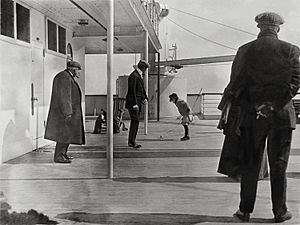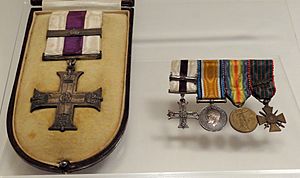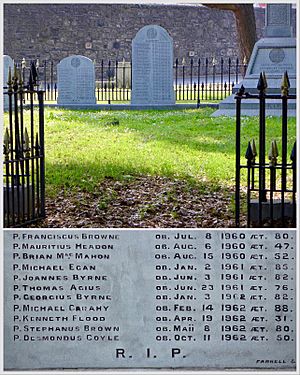Francis Browne facts for kids
Quick facts for kids The Reverend Father Francis Browne MC & Bar |
|
|---|---|

Fr Browne in 1939
|
|
| Church | Roman Catholic |
| Province | Society of Jesus |
| Orders | |
| Ordination | 31 July 1915 |
| Personal details | |
| Birth name | Francis Patrick Mary Browne |
| Born | 3 January 1880 Cork, Ireland |
| Died | 7 July 1960 (aged 80) Dublin, Ireland |
| Buried | Glasnevin Cemetery, Dublin, Ireland |
| Nationality | Irish |
| Denomination | Roman Catholic |
| Parents | Brigid Hegarty and James Browne |
| Occupation | Priest; photographer of the RMS Titanic |
Francis Patrick Mary Browne (3 January 1880 – 7 July 1960) was a famous Irish Jesuit priest and a talented photographer. He is best known for his pictures of the RMS Titanic. He took these photos of the ship, its passengers, and crew just before it sank in 1912. He also served bravely as a military chaplain during World War I.
Contents
Early Life and First Camera
Francis Browne was born in Cork, Ireland, in 1880. He was the youngest of eight children. Sadly, his mother passed away shortly after he was born. His father also died when Francis was nine years old.
After his parents' deaths, his uncle, Robert Browne, took care of him. His uncle was a Bishop and gave Francis his first camera. This was just before Francis went on a trip around Europe in 1897. This trip was where he started taking many photographs.
Education and Studies
Francis went to several schools in Ireland as he grew up. He later joined the Jesuits, a religious order of priests. He studied at the Royal University of Ireland in Dublin. Here, he was classmates with the famous writer James Joyce. Joyce even included a character based on Francis in one of his books!
In 1909, Francis visited Rome with his uncle and brother. They had a special meeting with Pope Pius X. The Pope even allowed Francis to take his picture! From 1911 to 1916, Francis studied to become a priest.
Aboard the Titanic

In April 1912, Francis received an amazing gift from his uncle. It was a ticket for the first trip of the RMS Titanic! The ship was sailing from England to Ireland and then on to New York.
Francis boarded the Titanic on April 10, 1912. He took many photos of life on board the ship. He captured images of the gym, the radio room, and the fancy dining hall. He also photographed passengers walking on the decks. These pictures are the last known images of many people who were on the ship. This included the captain, Edward J. Smith.
During his trip, Francis met a wealthy American couple. They liked his company and offered to pay for his ticket to New York. Francis asked his religious superior for permission to continue the journey. However, the reply was very clear: "GET OFF THAT SHIP – PROVINCIAL." This meant he had to leave the ship.
Francis Browne got off the Titanic when it stopped in Queenstown (now Cobh), Ireland. He then went back to Dublin to continue his studies. When he heard the terrible news that the ship had sunk, he realized his photos were very important. He sold them to newspapers all over the world. The Eastman Kodak company was so impressed that they gave him free film for life!
Later Life and Adventures
Serving in World War I

After becoming a priest in 1915, Francis joined the Irish Guards as a chaplain. He served during World War I from 1916 to 1920. He was present at major battles like the Battle of the Somme.
Francis was injured five times during the war, once seriously in a gas attack. He was very brave and was given two Military Cross awards. These awards are for showing great courage in battle. He also received an award from France called the Croix de Guerre.
During his time in Europe, Francis took many powerful photographs. One of his most famous war pictures is called "Watch on the Rhine."
Photography After the War
After the war, Francis returned to Dublin. He continued his work as a priest. In 1924, because of his health, he traveled to Australia. He took his camera everywhere, photographing life on the ship and in places like Cape Town, South Africa. In Australia, he captured images of farms, industries, and new immigrants.
On his way back to Ireland, he visited many other countries. He took photos of local life at every stop. It is believed that Francis Browne took more than 42,000 photographs in his lifetime! He photographed everything from old sailing ships to modern airplanes.
Discovering His Photographs
Francis Browne passed away in Dublin in 1960. He was buried in a special plot for Jesuits in Glasnevin Cemetery. For 25 years after his death, his thousands of photo negatives were forgotten.
Then, in 1985, another priest named Father Edward E. O'Donnell found them by chance. They were in a large metal trunk that belonged to Francis. When the trunk was opened, people realized how amazing his work was. Experts compared him to famous photographers like Henri Cartier Bresson.
His Titanic photographs were published in a book in 1997. Since then, more than 25 books of his photos have been published. These books have become very popular. One newspaper called the discovery of his photos "the photographic equivalent to the discovery of the Dead Sea Scrolls."
The Jesuit order, which owns the negatives, worked with experts to save and organize them. They are now making digital copies of all his usable images. This way, future generations can enjoy Francis Browne's incredible work. In 2012, a special Irish postage stamp was even made to honor him and the 100th anniversary of the Titanic sinking.


